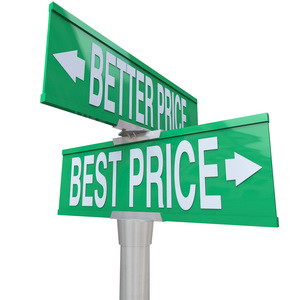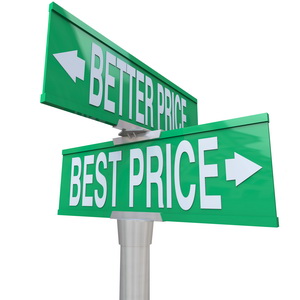A graphic designer recently confided that she really had no idea if her prices were right. Her firm was successful, and they made decent money. But she knew some firms charged quite a bit more, and she wondered if she could raise her rates. At the same time, she hated that her firm lost work because they were too expensive, and she knew she could work on a smaller profit margin and capture more work. “Shouldn’t someone who’s been doing this for years have this figured out by now?” she asked me.

In my experience, this conundrum is quite common. Many successful business owners struggle to figure out their pricing. And with good reason. While there is an element of science to pricing strategy, there is also a lot of art and a big dose of trial and error.
In working with hundreds of entrepreneurs, I’ve seen some consistent patterns that are cutting their business’ profitability. So today I want to share five common mistakes I see, and how to avoid or correct them.
[margin30]
[div style=”float:left;margin-right:20px”]
1
[/div]
[div style=”overflow:hidden”]
Too Low
While you and I have probably never met, I am guessing your prices are too low. Most small businesses’ prices are. There are a variety of possible reasons for this: you just haven’t gotten around to raising them in a while, you’re nervous to upset the apple cart, you hate turning away business, etc. There is just a general inertia in most businesses that tends to keep pricing low–lower than most of your clients are willing to pay. I go into this more in Five Reasons to Raise Your Prices.
A good way to test higher prices is with new clients. Increase your next few quotes by 10%, 20% or 30%, and see what happens. Most people I work with are pleasantly surprised.
[/div]
[margin30]
[div style=”float:left;margin-right:20px”]
2
[/div]
[div style=”overflow:hidden”]
Prices Inconsistent with Each Other
I helped a music school to grow their profitability. When the owner showed me all of his prices for various services, I couldn’t make sense of the prices relative to each other. They had a 4-week class that cost about the same as an 8-week class. People who signed up for a year of private lessons paid the same hourly rate as people who dropped in for a single lesson. And they had a few different one-hour programs which ranged in price from $30 to $250.
Over the years, the music school had developed new services and refined existing programs, tinkering with a price here and a price there. So they ended up with this hodgepodge. The unfortunate result was that, in my opinion, they were underpricing many programs and (inadvertently) steering customers to these less expensive options. When we looked at all of the prices side-by-side, we saw the inconsistencies and were able to adjust rates up or down to make them internally consistent. As a result, demand for their programs redistributed, and the school’s profit margin increased.
[/div]
[margin30]
[div style=”float:left;margin-right:20px”]
3
[/div]
[div style=”overflow:hidden”]
Not Offering a “Step Up” Option
When you look at a restaurant’s wine list, there are some premium bottles. When you visit McDonald’s, you have the option to “supersize it.” What options are you offering your clients to step up and invest more in your services?
Step-up options have two big benefits. First, my clients are inevitably surprised how many clients elect to buy a bigger program. And second, those who decline the step-up come to see the normal price as more reasonable in comparison. In other words, offering a $100 bottle of wine makes someone more likely to buy the $50 bottle, than if $50 was the highest price on the list.
Check out my article on how to implement the step-up strategy.
[/div]
[margin30]
[div style=”float:left;margin-right:20px”]
4
[/div]
[div style=”overflow:hidden”]
Round Numbers
Why is it that stores sell things for $49 or $199 instead of $50 or $200? It’s because they actually sell more units by pricing below psychological break points. It may sound cheesy, but stores do it because it works. Most people are more likely to buy something at $49 than at $50; it just feels more affordable.
While I don’t recommend pricing professional services with lots of 9’s, I do recommend you consider these psychological breakpoints. Doing a proposal for $20,000? What about $18,500? Or, if you’re going to hit the $20K mark anyway, consider jumping up to $23,000, which doesn’t feel much more expensive than $20,000.
[/div]
[margin30]
[div style=”float:left;margin-right:20px”]
5
[/div]
[div style=”overflow:hidden”]
Not Pricing in Your Own Time
I’ve worked with several general contractors. Before sending a proposal, these guys do a very detailed estimate of job costs–labor, materials, equipment usage, etc. One cost that they often don’t include, however, is the value of their own time. I find many other business owners overlook this. There’s often a sense that they’ll be somehow paid out of whatever money is left over. Often it works out fine, but often it does not. We’ve all had jobs go south and lost money on them.
When making your proposals, be sure to consider the value of your time, as well as the time of any other owners or managers who will work on this project. If you’re not sure how to value your time, consider the cost of hiring a freelancer with a similar skill level to come do this work.
[/div]
Share Your Thoughts
What have you learned about pricing over the years? What traps have you fallen into? What will you change about your prices after reading this? I look forward to hearing your insights and “ahas” below!
